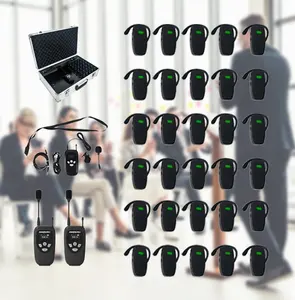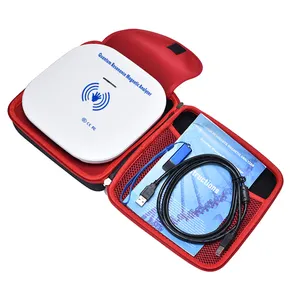Phổ biến trong ngành của bạn

JT-301 một cách Thì Thầm âm thanh hướng dẫn du lịch hệ thống tai nghe không dây Micro thu và phát cho cuộc họp nhà máy
14,00 US$ - 32,00 US$
Đơn hàng tối thiểu: 2 Cái
Vận chuyển mỗi chiếc: 3,74 US$


Vollgo OEM/ODM kích thước nhỏ điện năng thấp CC1101 433MHz RF mô-đun 10dBm SPI SMD dài Phạm vi RF mô-đun
1,98 US$ - 2,85 US$
Đơn hàng tối thiểu: 2 Cái


Máy Phát Siêu Âm Áp Điện MANORSHI 40Khz, Máy Thu Và Máy Bay Không Người Lái Cảm Biến Siêu Âm 16MM
0,30 US$ - 1,00 US$
Đơn hàng tối thiểu: 1 Cái


Dc12v 1CH relay điều khiển từ xa receiver module phổ không dây 433 MHz RF Transmitter nhận từ xa
Sẵn sàng vận chuyển
2,19 US$ - 4,79 US$
Đơn hàng tối thiểu: 10 Bộ
Vận chuyển mỗi chiếc: 2,16 US$


An1312 tầm xa Receiver và mô-đun Máy phát điện năng thấp sub-g ti cc1312r RF mô-đun 433 Mhz 868MHz 915 MHz ODM tùy chỉnh
4,91 US$ - 5,46 US$
Đơn hàng tối thiểu: 100 Cái
Vận chuyển mỗi chiếc: 0,47 US$


QN-KIT03 433Mhz Long Range Máy Phát Và Máy Thu
12,40 US$ - 15,00 US$
Đơn hàng tối thiểu: 50 Cái
Vận chuyển mỗi chiếc: 4,80 US$

Bộ Phát Và Thu Dữ Liệu Không Dây 10KM 433Mhz, Mô Đun Thu Phát Dữ Liệu Vô Tuyến 5W RF RS232 / RS485 / TTL
100,00 US$ - 120,00 US$
Đơn hàng tối thiểu: 2 Đơn vị

Dài phạm vi ti cc1312r cc1312 linh hoạt công suất thấp điều khiển vô tuyến 433 Mhz 868MHz 915 MHz Receiver và máy phát RF Lora mô-đun
4,98 US$ - 5,15 US$
Đơn hàng tối thiểu: 1 Cái
Vận chuyển mỗi chiếc: 6,27 US$

Trên không cần cẩu điều khiển từ xa Palăng công nghiệp không dây điều khiển từ xa 433MHz RF máy phát và máy thu
34,00 US$ - 36,00 US$
Đơn hàng tối thiểu: 1 Bộ
Vận chuyển mỗi chiếc: 26,15 US$

Bộ Thu Phát Vô Tuyến Điều Khiển Từ Xa Hai Chiều YET402PC
3,70 US$ - 3,99 US$
Đơn hàng tối thiểu: 100 Cái

F21-4S 433Mhz Phụ Kiện Thủy Lực RC Dữ Liệu Vô Tuyến Không Dây Và Mô-đun Thu
33,00 US$ - 54,00 US$
Đơn hàng tối thiểu: 1 Cái

Đài Phát Thanh Điều Khiển Từ Xa RC Bộ Thu Cho Cửa Nhà Để Xe 2 Kênh 433Mhz JJ-JS-091
Sẵn sàng vận chuyển
6,80 US$ - 8,00 US$
Đơn hàng tối thiểu: 2 Bộ
Vận chuyển mỗi chiếc: 18,00 US$
Các tìm kiếm liên quan:
máy phát và máy thu vô tuyến sóng ngắnrc radio transmitter và receivermáy thu phát vô tuyến công nghiệpmáy phát và máy thu 1kmmáy phát và máy thu 433mhzmáy phát và máy thu 10kmkhông dây 433mhz transmitter và receiver433/868/915mhz transmitter và receiver433mhz radio transmitter receiverrf 868mhz máy phát và nhậnrc 2km máy phát và máy thu433mhz máy phát từ xa 315 mhzmáy thu phát frskybộ thu phát liên kết vô tuyếnmáy phát từ xa yet001

Nút Thu Và Phát Điều Khiển Từ Xa Vô Tuyến Không Dây F21-E2 Điều Khiển Từ Xa Công Nghiệp
125,00 US$ - 145,00 US$
Đơn hàng tối thiểu: 1 Cái

Fsk Ac380v 12 Nút 433Mhz Phổ Học Tập Mã Máy Phát Và Máy Thu Công Nghiệp Đài Phát Thanh Điều Khiển Từ Xa Cần Cẩu
24,99 US$ - 37,99 US$
Đơn hàng tối thiểu: 10 Cái

Bộ Thu Và Phát Vô Tuyến Không Dây F21-E1B Điều Khiển Từ Xa Cần Cẩu Công Nghiệp Phổ Quát
Sẵn sàng vận chuyển
26,90 US$ - 29,90 US$
Đơn hàng tối thiểu: 2 Bộ
Vận chuyển mỗi chiếc: 8,84 US$

Tuỳ Chỉnh Hồng Ngoại Đài Phát Thanh Điều Khiển Từ Xa Máy Photocopy Rf Transmitter Và Nhận 433Mhz Nhôm Bìa
2,50 US$ - 4,98 US$
Đơn hàng tối thiểu: 500 Cái

433Mhz 868MHz 915MHz 500mW 3km USB RS232 dữ liệu không dây thu phát RF module, chuyên nghiệp UART dữ liệu truyền và nhận
23,00 US$ - 45,00 US$
Đơn hàng tối thiểu: 2 Cái
Vận chuyển mỗi chiếc: 7,14 US$

AS32-DTU Bộ Thu Và Phát Tín Hiệu Vô Tuyến Lora Sx1278 Modbus Rs485 100 Mhz Tầm Xa 433 Mw
14,95 US$ - 17,55 US$
Đơn hàng tối thiểu: 2 Cái
Vận chuyển mỗi chiếc: 7,95 US$

Bộ Thu Và Phát Không Dây Điều Khiển Từ Xa RF 2 Chiều 433Mhz Cho Dụng Cụ Mở Cổng 12V/24V
6,00 US$ - 7,50 US$
Đơn hàng tối thiểu: 300 Cái

433 Mhz 4 KÊNH Transmitter/receivers RF máy phát và máy thu 433 MHz RF mô-đun RF không dây mô-đun
0,88 US$ - 1,10 US$
Đơn hàng tối thiểu: 100 Mẫu Anh

Tùy Chỉnh Đài Phát Thanh Hồng Ngoại Điều Khiển Từ Xa Máy Photocopy Rf Máy Phát Và Máy Thu 433Mhz Nhôm Bìa
1,02 US$ - 1,42 US$
Đơn hàng tối thiểu: 100 Cái

Q202 433MHz 48V Máy Phát Và Máy Thu Thang Máy Chuyển Hoist Phổ Crane Không Dây Điện Đài Phát Thanh Công Nghiệp Điều Khiển Từ Xa
Sẵn sàng vận chuyển
47,90 US$ - 58,70 US$
Đơn hàng tối thiểu: 1 Cái
Vận chuyển mỗi chiếc: 23,02 US$

E23-433M13S mới ebyte 433M SPI sx1212 433Mhz 13dBm 800m IPX Tần số vô tuyến giao diện RF không dây máy phát và máy thu
2,27 US$ - 2,55 US$
Đơn hàng tối thiểu: 2 Cái

8 nút 12-24V AC/DC hoist Crane công nghiệp không dây đài phát thanh điều khiển từ xa máy phát và máy thu cho 12V 24V trên không cầu
Sẵn sàng vận chuyển
48,60 US$ - 50,00 US$
Đơn hàng tối thiểu: 2 Cái
Vận chuyển mỗi chiếc: 27,96 US$

Nhà Máy F24-8S Giá Chi Phí Thấp Đài Phát Thanh Máy Phát Và Receiver Cần Cẩu Điều Khiển Từ Xa Tail Lift
165,00 US$
Đơn hàng tối thiểu: 2 Đơn vị

Bộ Phát Từ Xa Rf Yet026 433Mhz Và Bộ Thu Động Cơ Dc 12 Volt 2 Kênh
6,70 US$ - 7,50 US$
Đơn hàng tối thiểu: 2 Cái

Bộ Phát Từ Xa Rf Yet026 433Mhz Và Bộ Thu Động Cơ Dc 12 Volt 2 Kênh
6,70 US$ - 7,50 US$
Đơn hàng tối thiểu: 2 Cái
Vận chuyển mỗi chiếc: 10,38 US$

Bộ Thu Và Truyền Dữ Liệu Không Dây TTL RS232 RS485, Mô Đun Tần Số Vô Tuyến 433Mhz 868Mhz 915Mhz
36,00 US$
Đơn hàng tối thiểu: 1 Bộ

Công Tắc Điều Khiển Từ Xa Tự Động Hóa Gia Đình 18CH AC 220V Bộ Phát Và Thu RF 433MHZ Công Tắc Không Dây Điều Khiển Vô Tuyến Gia Đình Thông Minh
Sẵn sàng vận chuyển
10,00 US$ - 25,00 US$
Đơn hàng tối thiểu: 10 Cái
Vận chuyển mỗi chiếc: 2,24 US$

Đài phát thanh điều khiển từ xa hệ thống Receiver 3000M tầm xa khoảng cách Transmitter 1/2/3CH điều khiển từ xa 433Mhz
1,70 US$ - 1,90 US$
Đơn hàng tối thiểu: 30 Cái

F24-18S đài phát thanh máy phát và máy thu 18 nút công nghiệp không dây điều khiển từ xa hoist Crane
120,00 US$ - 130,00 US$
Đơn hàng tối thiểu: 2 Cái
Vận chuyển mỗi chiếc: 16,57 US$

Không dây điều khiển từ xa chuyển đổi DC 24V 2CH tiếp sức cửa nhà để xe hàng rào RF máy phát và máy thu 433Mhz
Sẵn sàng vận chuyển
4,00 US$ - 4,60 US$
Đơn hàng tối thiểu: 10 Cái
Vận chuyển mỗi chiếc: 1,81 US$

Bộ Thu Hệ Thống Công Tắc Điều Khiển Từ Xa Vô Tuyến Không Dây RF 433MHZ DC 12V 24V 6CH Cho Tự Động Hóa Nhà Thông Minh
11,50 US$
Đơn hàng tối thiểu: 100 Bộ

F24-6S mạnh mẽ và bền hoist nâng chống sốc không dây máy phát và máy thu công nghiệp đài phát thanh điều khiển từ xa
57,00 US$ - 69,00 US$
Đơn hàng tối thiểu: 1 Bộ

Chi phí thấp tự động hóa Nhà Tần số vô tuyến máy phát và máy thu HF-BL500 xbee mô-đun cho người tiêu dùng điện tử
Sẵn sàng vận chuyển
0,90 US$ - 1,02 US$
Đơn hàng tối thiểu: 1000 Cái
Vận chuyển mỗi chiếc: 0,20 US$

Hồng ngoại đài phát thanh điều khiển từ xa máy photocopy RF máy phát và máy thu 433Mhz nhôm Bìa Air Chuột
0,68 US$ - 0,78 US$
Đơn hàng tối thiểu: 500 Cái

Công Tắc Điều Khiển Từ Xa Không Dây Phổ Thông 433 Mhz Mô Đun Máy Thu Rơ Le DC 12V 1CH, Điều Khiển Từ Xa 433 Mhz
Sẵn sàng vận chuyển
3,02 US$ - 4,32 US$
Đơn hàng tối thiểu: 100 Bộ

Đài phát thanh điều khiển từ xa transmitter và receiver 433 mhz, không dây điều khiển từ xa 8 nút chức năng F24-8D
145,00 US$ - 150,00 US$
Đơn hàng tối thiểu: 1 Bộ

Công Tắc Đèn Điều Khiển Từ Xa Không Dây RF Mini Công Tắc Đầu Ra Rơ-le 10A Radio DC 12V 1 CH Mô Đun Thu Kênh + Bộ Phát
Sẵn sàng vận chuyển
2,50 US$ - 4,70 US$
Đơn hàng tối thiểu: 1 Cái
Vận chuyển mỗi chiếc: 4,79 US$

Rc 2-kênh Receiver với đa tần số 300-868MHz 433Mhz 315Mhz 12V/24V giao tiếp không dây thông qua RF & Wifi điều khiển từ xa
5,10 US$ - 6,50 US$
Đơn hàng tối thiểu: 1 Cái
Vận chuyển mỗi chiếc: 6,87 US$
Các danh mục hàng đầu
Giới thiệu về máy phát và máy thu vô tuyến 433mhz
Ngày nay, máy phát và máy thu vô tuyến 433mhz không còn là điều mới mẻ đối với những người bình thường và không còn bị coi là điều cấm kỵ khi sử dụng. Nếu bạn đang tìm kiếm niềm vui áp chót đó, bạn phải kiểm tra sự bao la. Bộ sưu tập máy phát và máy thu vô tuyến 433mhz tại Alibaba.com. Những gợi cảm và cong. máy phát và máy thu vô tuyến 433mhz đáng giá từng xu và chắc chắn làm cho đêm đó trở nên đặc biệt đối với bạn. Những con búp bê này có ngoại hình giống như thật, bắt đầu từ tóc đến ngón chân theo mọi nghĩa.
Cho dù bạn là một người cô đơn đang tìm kiếm một người bạn đời như cuộc sống hay một cặp vợ chồng muốn thêm gia vị cho cuộc sống của họ, bạn đều có thể sử dụng chúng . máy phát và máy thu vô tuyến 433mhz để đốt cháy ngọn lửa đó. Những ngoạn mục. máy phát và máy thu vô tuyến 433mhz có thể tùy chỉnh theo mong đợi của bạn. Những điều tuyệt vời. máy phát và máy thu vô tuyến 433mhz có sẵn ở cả phiên bản dành cho nam và nữ và được làm từ silicone cấp y tế để sử dụng an toàn. Hãy sở hữu ngay bây giờ và tận hưởng một đêm đam mê và cháy bỏng.
Alibaba.com cung cấp những điều tuyệt vời này. máy phát và máy thu vô tuyến 433mhz ở mọi hình dạng cơ thể, kích thước và sắc tộc. Dù yêu cầu của bạn đối với. máy phát và máy thu vô tuyến 433mhz, bạn có thể tải tất cả chúng trên trang web. Những cái này. máy phát và máy thu vô tuyến 433mhz được tạo hình bởi những người thợ thủ công giỏi nhất và mọi chi tiết phức tạp đều được kiểm tra kỹ lưỡng. Những con búp bê này có mắt, tóc, móng tay và tất cả các bộ phận cơ thể khác tương tự như người thật.
Alibaba.com cung cấp nhiều loại. máy phát và máy thu vô tuyến 433mhz có thể giúp bạn mua các sản phẩm phù hợp với ngân sách và các yêu cầu khác của bạn. Các sản phẩm này an toàn để sử dụng, được chứng nhận và thân thiện với môi trường trong tự nhiên. Đơn đặt hàng OEM có sẵn trên các sản phẩm này.
Cho dù bạn là một người cô đơn đang tìm kiếm một người bạn đời như cuộc sống hay một cặp vợ chồng muốn thêm gia vị cho cuộc sống của họ, bạn đều có thể sử dụng chúng . máy phát và máy thu vô tuyến 433mhz để đốt cháy ngọn lửa đó. Những ngoạn mục. máy phát và máy thu vô tuyến 433mhz có thể tùy chỉnh theo mong đợi của bạn. Những điều tuyệt vời. máy phát và máy thu vô tuyến 433mhz có sẵn ở cả phiên bản dành cho nam và nữ và được làm từ silicone cấp y tế để sử dụng an toàn. Hãy sở hữu ngay bây giờ và tận hưởng một đêm đam mê và cháy bỏng.
Alibaba.com cung cấp những điều tuyệt vời này. máy phát và máy thu vô tuyến 433mhz ở mọi hình dạng cơ thể, kích thước và sắc tộc. Dù yêu cầu của bạn đối với. máy phát và máy thu vô tuyến 433mhz, bạn có thể tải tất cả chúng trên trang web. Những cái này. máy phát và máy thu vô tuyến 433mhz được tạo hình bởi những người thợ thủ công giỏi nhất và mọi chi tiết phức tạp đều được kiểm tra kỹ lưỡng. Những con búp bê này có mắt, tóc, móng tay và tất cả các bộ phận cơ thể khác tương tự như người thật.
Alibaba.com cung cấp nhiều loại. máy phát và máy thu vô tuyến 433mhz có thể giúp bạn mua các sản phẩm phù hợp với ngân sách và các yêu cầu khác của bạn. Các sản phẩm này an toàn để sử dụng, được chứng nhận và thân thiện với môi trường trong tự nhiên. Đơn đặt hàng OEM có sẵn trên các sản phẩm này.











